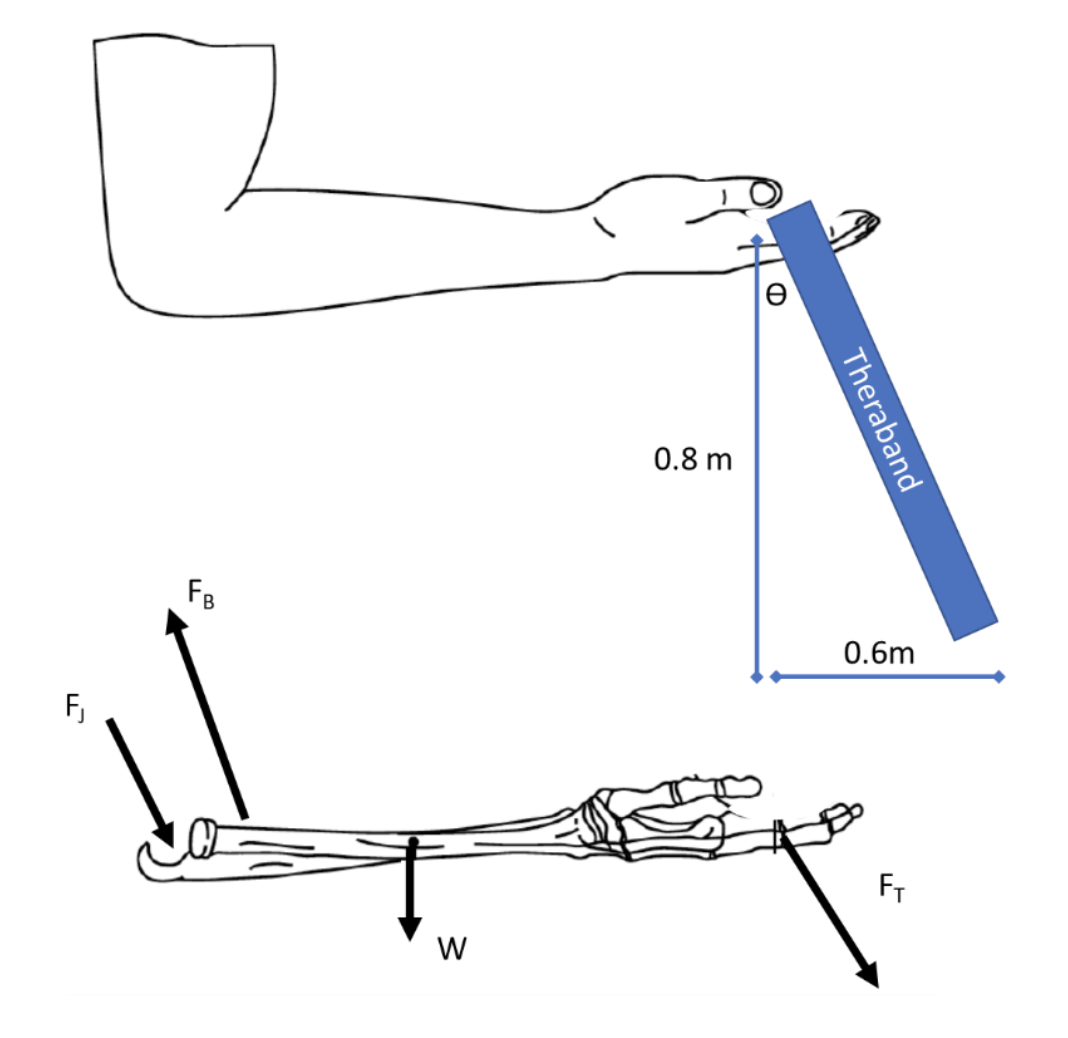It’s an arm day at the gym and all the free weights and machines are taken. You don’t have much time to squeeze in your workout before your next class. Desperate to get your reps in, you see a pile of Therabands (the giant rubber bands used for physical therapy). The bands are 100 mm wide and 1.5 mm thick. You sit down to do some bicep curls with the Theraband tied to rack 60 cm away from your hand and your hand is 80 cm from the floor. However, a single length of the Theraband is too easy to curl, so you end up wrapping it around your hand twice (i.e. you are stretching 4 lengths of Theraband when you do your reps). Your hand starts out 60 cm from the Theraband anchor point before your do your bicep curl (i.e. no stress on the band, band has no slack). You contract your bicep until your forearm is parallel with the floor and hand in the position below and hold static equilibrium. From previous obsessing over your personal biomechanics, you know the following: your arm and hand weigh 2 kg with a center of mass 12 cm distal from your elbow joint; you are holding the Theraband 35 cm from your elbow joint; your bicep muscle inserts 4 cm from your elbow joint and is positioned so it is contracting perpendicularly to the ground. You quickly get through your workout, but don’t know how it compares to your normal set of reps with free weights. When you get back to your dorm room, you look up the modulus of the Theraband and find that it is 0.5 MPa. (A) Determine the force applied by your bicep (magnitude, x and y components). (B) Determine the joint reaction force (magnitude, x and y components). (C) How does the force your muscle exerts compare to your normal workout of using 35 pound free weights?
It’s an arm day at the gym and all the free weights and machines are taken. You don’t
have much time to squeeze in your workout before your next class. Desperate to get your reps in,
you see a pile of Therabands (the giant rubber bands used for physical therapy). The bands are 100
mm wide and 1.5 mm thick. You sit down to do some bicep curls with the Theraband tied to rack 60
cm away from your hand and your hand is 80 cm from the floor. However, a single length of the
Theraband is too easy to curl, so you end up wrapping it around your hand twice (i.e. you are
stretching 4 lengths of Theraband when you do your reps). Your hand starts out 60 cm from the
Theraband anchor point before your do your bicep curl (i.e. no stress on the band, band has no
slack). You contract your bicep until your forearm is parallel with the floor and hand in the position
below and hold static equilibrium. From previous obsessing over your personal biomechanics, you
know the following: your arm and hand weigh 2 kg with a center of mass 12 cm distal from your
elbow joint; you are holding the Theraband 35 cm from your elbow joint; your bicep muscle inserts
4 cm from your elbow joint and is positioned so it is contracting perpendicularly to the ground. You
quickly get through your workout, but don’t know how it compares to your normal set of reps with
free weights. When you get back to your dorm room, you look up the modulus of the Theraband
and find that it is 0.5 MPa. (A) Determine the force applied by your bicep (magnitude, x and y
components). (B) Determine the joint reaction force (magnitude, x and y components). (C) How
does the force your muscle exerts compare to your normal workout of using 35 pound free weights?

Trending now
This is a popular solution!
Step by step
Solved in 2 steps






